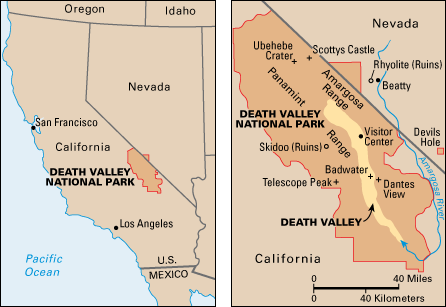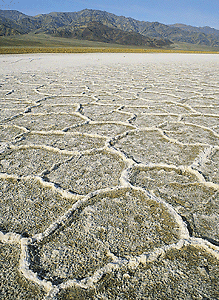Death Valley Regains Title as Hottest Place on Earth
September 18, 2012
The hottest surface temperature ever recorded on Earth was a scorching 134 °F (56.7 °C) measured in Death Valley, California, on July 10, 1913, a scientific panel has determined. The ruling was announced on September 13, 2012, by climate scientists convened by the World Meteorological Organization (WMO), an agency of the United Nations (UN). The scientists invalidated a long-disputed measurement of 136.4 °F (58 °C) taken at El Azizia, Libya, on September 13, 1922. They cited a number of problems with the Libyan reading, including unreliable instruments, an inexperienced observer, and a poorly chosen site.
Death Valley is a deep basin about 130 miles (209 kilometers) long and from 6 to 14 miles (10 to 23 kilometers) wide in California. It lies within Death Valley National Park, which extends into Nevada. A group of pioneers named the valley for its desolate desert environment after they crossed it in 1849. Death Valley includes the lowest and driest point in North America. It lies 282 feet (86 meters) below sea level. Average rainfall in the valley is only 2 inches (5 centimeters) per year.

Death Valley National Park lies chiefly in east-central California. Its northeast corner extends into Nevada. Death Valley, a deep trough, lies within the park. (World Book maps)
The record temperature in Death Valley was measured at a weather station at Greenland Ranch, now known as Furnace Creek Ranch. The caretaker at the ranch reportedly said that the day was so hot that swallows fell dead from the sky. According to the National Park Service (NPS), the 1913 heat record occurred during a week of five consecutive days with temperatures of at least 120 °F (54 °C). Recorded temperatures in Death Valley have also reached 129 °F (54 °C) in 1960, 1998, 2005, and 2007.

Death Valley, California, the country's driest place, receives about 2 inches (5 centimeters) of precipitation yearly. It recorded the highest temperature ever in the world, 134 °F (57 °C). (c) Ken N. Johns, Photo Researchers
Death Valley owes its extreme heat to its steep walls and low floor, according to the park’s website. Aided by clear air and sparse vegetation, sunlight bakes the desert floor. Trapped heat radiated from rocks and soil also helps produce super-hot air masses that blow through the valley.
Additional World Book articles:


